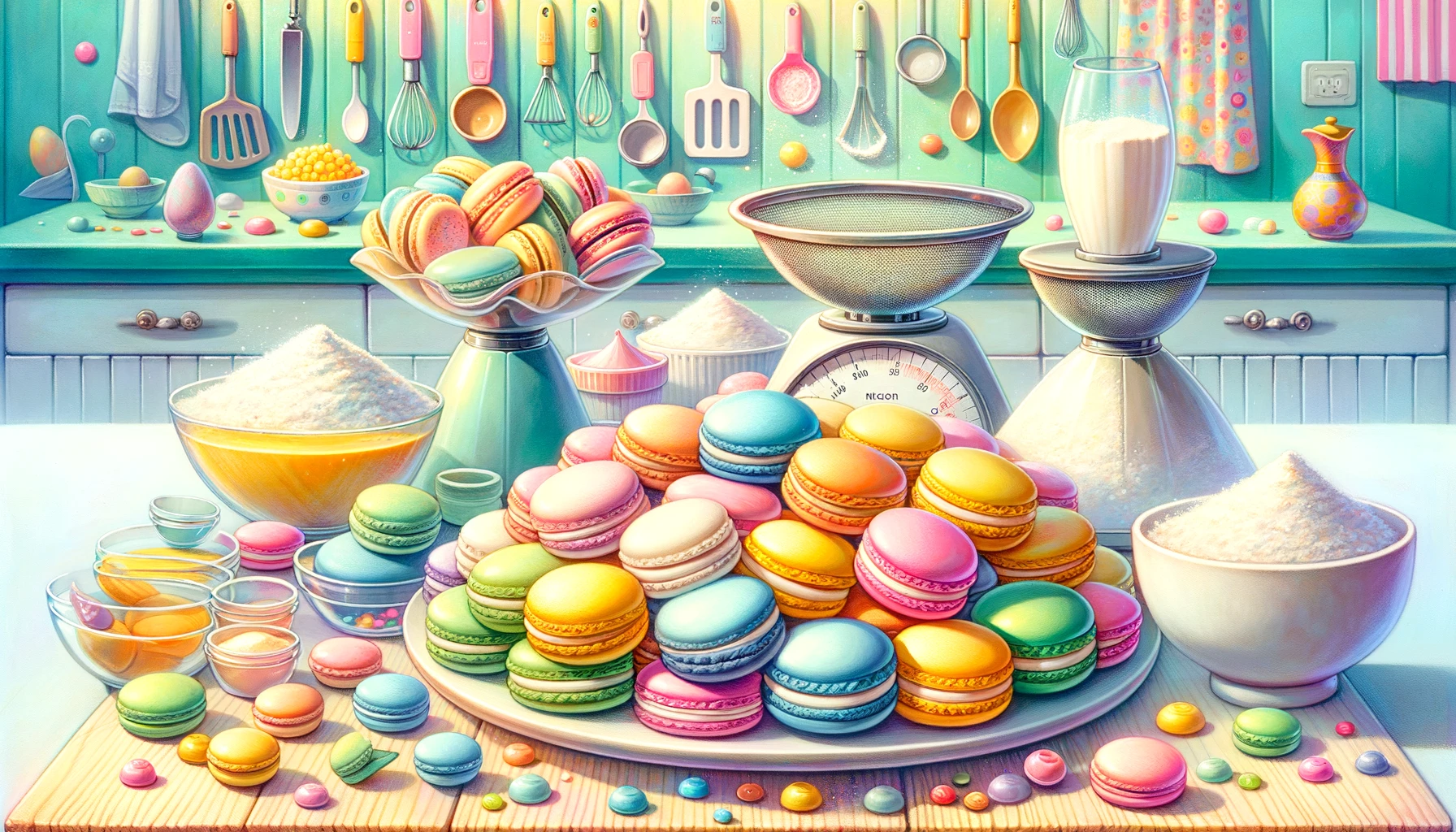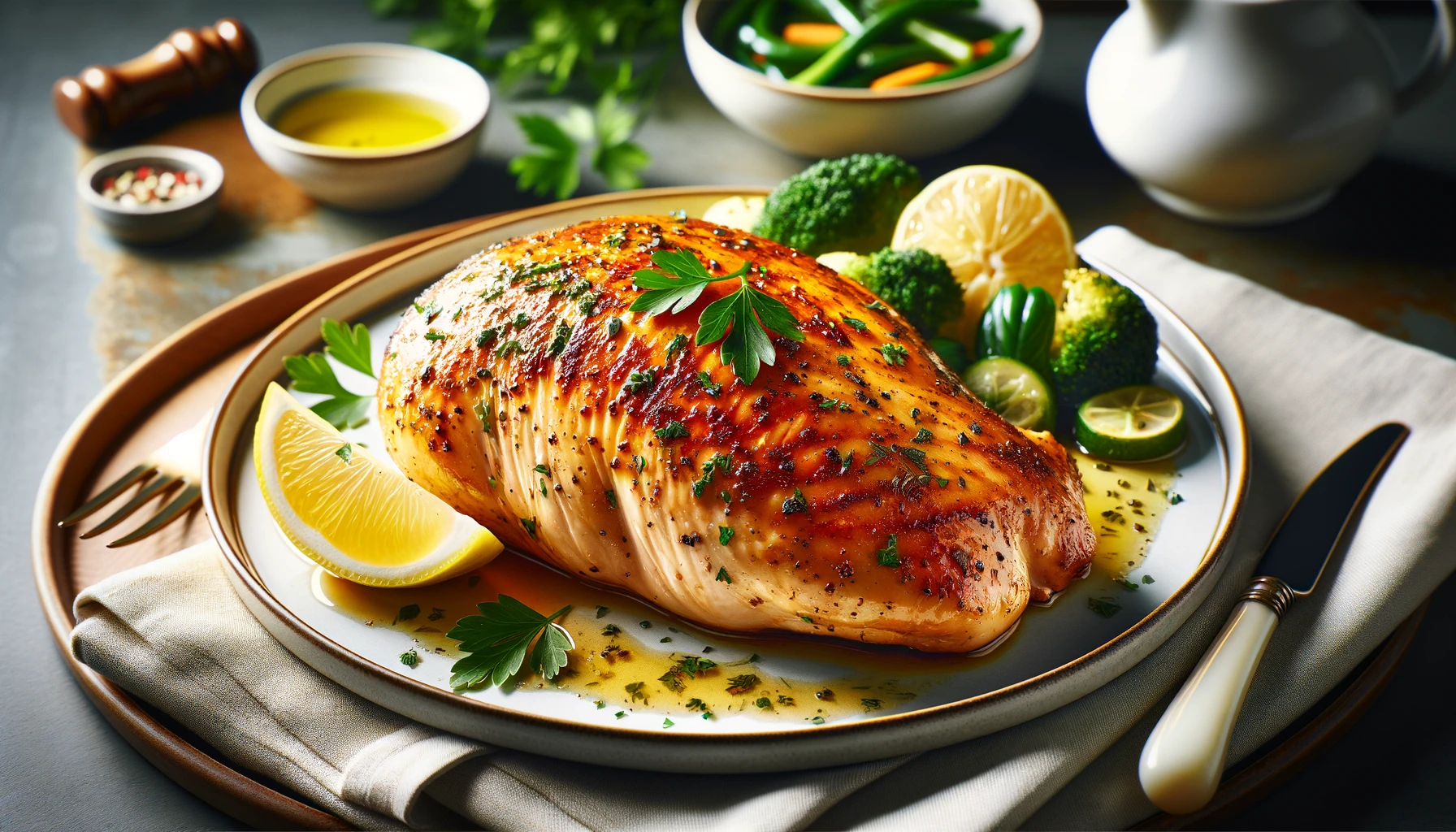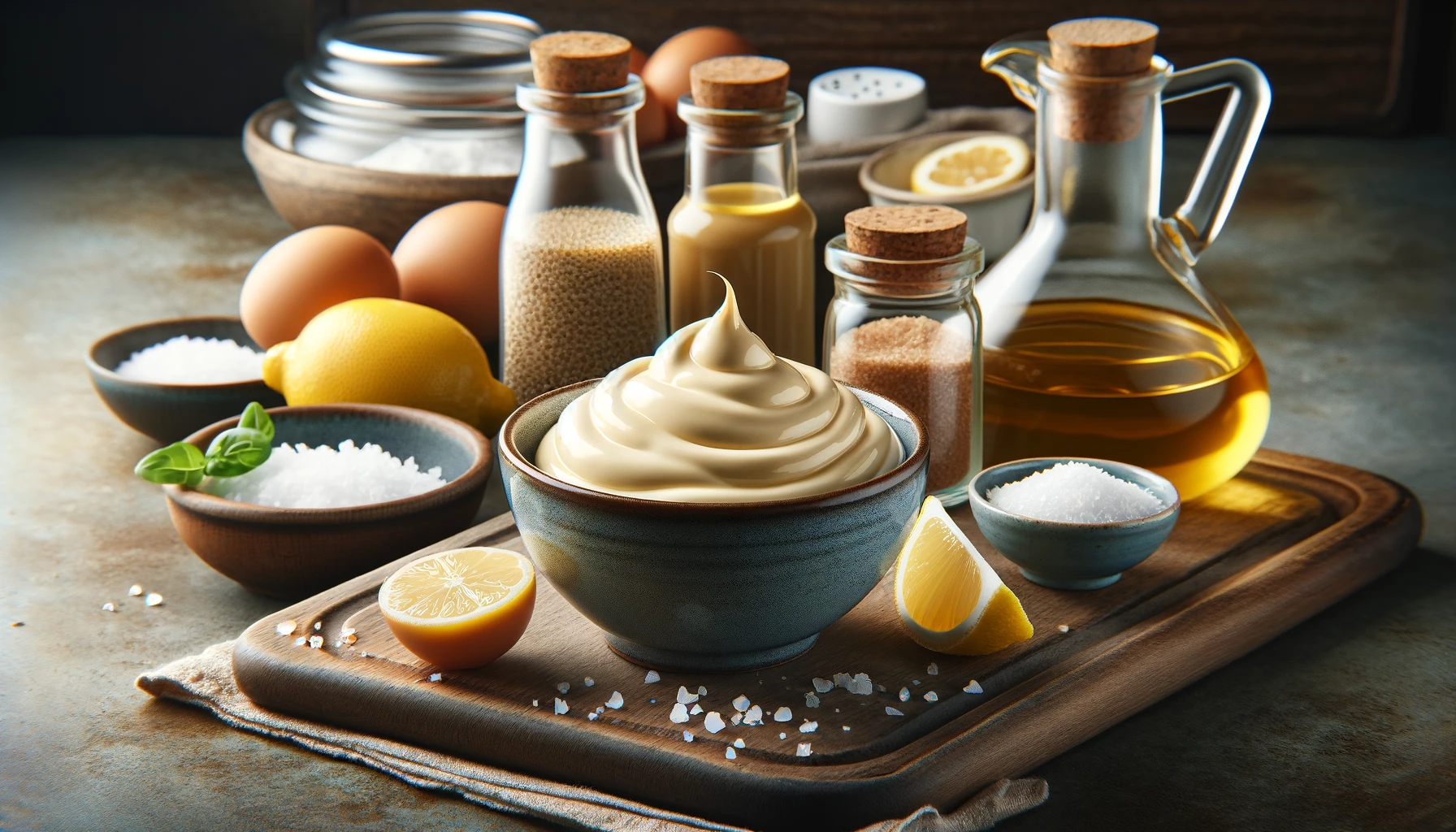Congratulations! You’ve decided to attempt the Everest of baking: the French macaron. Those little pastel sandwich clouds that have broken many a baker’s heart with their footless, hollow, or cracked exterior. But, fear not! Here’s a foolproof guide (well, fool-ish-proof, at least) to achieve macaron success – or at least a good laugh.
Ingredients:
- 1 cup of sheer determination
- A splash of wild optimism
- 3 aged egg whites (because apparently, they need life experience before turning into a macaron)
- 1/4 cup of granulated sugar (that’s sweet stuff, in case you forgot)
- 2 cups powdered sugar (or as we call it, sneeze-inducing fairy dust)
- 1 cup almond flour (not to be confused with the almond’s extroverted cousin, almond butter)
- A pinch of cream of tartar (not to be mistaken for actual tartar sauce, that’s a different recipe)
- 1/4 tsp of salt (because life’s too short to not be salty)
- A dash of whatever food coloring matches your mood (optional, but if you want Insta-worthy macarons…)
Instructions, or How to Not Lose Your Sanity:
1. Age Your Egg Whites: If you’re wondering, “Why aged?” well, so are we. Apparently, old egg whites whip up better than fresh ones. Leave them out on the counter for 24 hours. If you forget and use fresh egg whites, just blame the macaron gods when they don’t rise perfectly.
2. Sift, Don’t Snort: Mix the powdered sugar and almond flour. Sift it at least twice. If you’re asking, “Why twice?” again, it’s tradition (or torture, depending on how you view it). It’s to avoid any lumpy bumpy surprises.
3. Whipping It Real Good: Whip those aged egg whites until they foam up like a bubble bath, then slowly add the granulated sugar. Add cream of tartar and salt. Whisk until you get stiff peaks. Not to be mistaken with soft peaks, medium peaks, or mountain peaks.
4. Folding Fun: Here comes the fun part! No, not eating, not yet. You need to fold the dry ingredients into the egg whites. And fold. And fold. And probably fold some more. You’re aiming for a lava-like consistency. If you don’t know what lava looks like, might I suggest watching some documentaries?
Now, I know I promised a fool-ish-proof method, but here’s where the real challenge begins. The key is to fold until it’s mixed but not over-mixed. Under-mix, and you’ll get peaked tops; over-mix, and you’ll get flat cookies. Just remember: fold as if your macaron’s life depended on it – because it does.
5. Piping Like Picasso: Grab a piping bag and try to act like you know what you’re doing. If you don’t have a piping bag, a zip-lock bag with a corner cut off will do. Pipe out small circles onto a baking sheet. If your circles look more like amoebas, just remember that amoebas are a form of life too, and they’re beautiful in their own unique, single-celled way.
6. The Waiting Game: Once piped, let your precious macarons sit out and form a skin for 30 minutes. This is not only crucial but an opportunity for you to reflect upon your life choices – specifically, why you decided to make macarons in the first place.
7. Bake, but Don’t Burn: Preheat your oven to 325°F (165°C) – or a few degrees higher if your oven has a personality of its own. Pop those bad boys in and bake for about 10 minutes. If they don’t come out perfect, remember, it’s not you, it’s your oven. Or maybe it is you. No judgment.
8. The Filling Fiasco: Once baked and cooled, choose a filling. You can opt for buttercream, chocolate ganache, or if you’re feeling fancy, unicorn tears (though they’re a bit salty). Slather a generous amount on one macaron and sandwich it with another. If they break during this process, they’re just rustic. Rustic is in these days.
9. The Final Verdict: Allow the macarons to set in the fridge for a day (if you have that kind of self-control). Apparently, they taste better after 24 hours. I wouldn’t know, mine never make it past the 24-minute mark.
10. Celebrate! Whether they turned out perfect, or they look like something out of an abstract art gallery, give yourself a pat on the back. Remember, the journey of making macarons is filled with emotional turmoil, self-reflection, and an excessive amount of folding. Celebrate the fact that you took on this challenge and emerged from the other side, hopefully with a semblance of your sanity intact.
In Conclusion:
Macarons are delicate, delightful, and devilishly difficult. But even if yours didn’t turn out looking like the ones in the fancy Parisian shops, they’re yours. Embrace their imperfections, their quirks, and their deliciousness. And if all else fails, they’re the perfect treat to pair with a large glass of wine – because you certainly earned it.
Bonus: 3 Filling Recipes That’ll Make Your Wonky Macarons Shine (Or At Least Taste Heavenly)
1. Classic Vanilla Buttercream: Because sometimes, simple is best.
Ingredients:
- 1/2 cup unsalted butter, softened (because we want our arteries just right)
- 2 cups powdered sugar (for that dentist appointment you’ve been putting off)
- 1 tsp vanilla extract (for that classic aroma)
- 2-3 tbsp heavy cream (or milk, if you’re trying to be “healthy”)
Method:
- Beat the butter until it’s as smooth as your dance moves on a Friday night.
- Gradually add in the powdered sugar. You want this mixture creamy, not powdery.
- Mix in the vanilla extract. Feel free to take a whiff; we won’t judge.
- Adjust consistency with heavy cream until it’s rich and spreadable.
2. Chocolate Ganache Delight: For the chocoholics. Or anyone with a pulse, really.
Ingredients:
- 8 oz semi-sweet chocolate, chopped (or those chips you hide from the kids)
- 1 cup heavy cream
- A pinch of salt (because balance in life is key)
Method:
- Heat the heavy cream until it’s just about to boil.
- Pour it over the chopped chocolate, letting it sit for a minute. Think of this as a spa day for your chocolate.
- Stir until the mixture is smooth and glorious. Add that pinch of salt for a flavor pop!
3. Salted Caramel Bliss: Salty, sweet, and absolutely sinful.
Ingredients:
- 1 cup granulated sugar (life’s sweet, so is this filling)
- 6 tbsp unsalted butter, room temperature and cut into pieces (butter makes everything better)
- 1/2 cup heavy cream
- 1 tsp salt (or more, live your salty dream)
Method:
- Heat the sugar over medium heat, stirring constantly. It’ll clump, melt, and eventually turn into an amber-colored liquid.
- Once fully melted, add the butter. Stir until the butter is completely melted.
- Slowly pour in the heavy cream while stirring. Be careful, as the mixture will bubble up.
- Allow the mixture to boil for a minute. Remove from heat, stir in the salt, and let cool before filling your macarons.
Remember, the filling can make or break your macarons. Or, in this case, make them so delicious, no one cares what they look like! Happy Filling!
Pro Tips For Making Macarons
- Temperature Consistency: Ensure that all ingredients are at room temperature before starting. This helps with the consistency of the batter and the final texture of the macarons.
- Precision is Key: Use a kitchen scale for measuring ingredients. Macarons are finicky and require precise measurements for the best results.
- Macaronage Technique: The process of mixing the batter to the right consistency, known as ‘macaronage’, is crucial. Mix until the batter flows like lava and forms a thick ribbon when lifted with a spatula. It should blend back into the batter within about 30 seconds.
- Resting is Crucial: After piping, let the macarons rest until they form a skin. This can take anywhere from 15 minutes to an hour, depending on the humidity. You should be able to gently touch the surface without the batter sticking to your finger.
- Oven Thermometer: Use an oven thermometer to ensure the accuracy of your oven’s temperature. Even slight variations can affect the outcome.
- Silicone Baking Mats vs. Parchment Paper: Experiment with both to see which gives you better results. Some bakers swear by silicone mats, while others prefer parchment paper.
- Tap That Tray: After piping, tap the baking tray on the counter to release any air bubbles, which can cause cracks during baking.
- Rotate Halfway Through: For even baking, rotate the baking sheet halfway through the baking time.
- Patience with Peeling: Let the macarons cool completely before trying to remove them from the baking sheet. They peel off easier when fully cooled.
- Practice Makes Perfect: Don’t get discouraged. Making macarons is an art that requires practice. Each batch teaches you something new.
- Humidity Watch: Avoid making macarons on very humid days, as moisture can affect how they rise and develop feet.
- Flavoring Tips: For flavored macarons, add dry flavorings (like cocoa powder or espresso powder) to the almond flour and powdered sugar mixture. For colors, gel food colorings are better than liquid as they don’t alter the consistency of the batter.
- Storage Secret: Store filled macarons in the refrigerator for 24 hours before serving. This process, known as maturation, helps in developing the right texture and flavor.
- Troubleshooting Guide: Keep a note of what works and what doesn’t (oven temperature, resting time, batter consistency) to refine your technique each time.
Frequently Asked Questions About Making Macarons
Macarons without feet often result from under-whipped egg whites, too little resting time, or an oven temperature that’s too low. Ensure your egg whites reach stiff peaks, let the piped macarons rest until they form a skin, and check your oven temperature.
Hollows are usually due to over-whipped egg whites, incorrect folding technique, or too high an oven temperature. Aim for a smooth, lava-like batter and use an oven thermometer to verify the temperature.
Cracked macarons can be caused by not letting them rest long enough before baking or by air bubbles trapped in the batter. Ensure they form a skin before baking and tap the tray firmly after piping to release air bubbles.
To achieve round macarons, hold the piping bag vertically and close to the baking sheet. Pipe with even pressure and twist the bag as you finish piping. A template under the parchment paper can also help.
Humidity can affect macarons, making it hard for them to set and develop feet. If it’s unavoidable, use a dehumidifier in the kitchen or wait for a drier day.
Macarons are done when they are firm on their feet and can be slightly wiggled off the baking sheet. Overbaked macarons become too crispy, and underbaked ones are chewy.
Filled macarons can be stored in the refrigerator for up to a week. For longer storage, they can be frozen for up to three months. Always store them in an airtight container.
Macarons traditionally require almond flour for their unique texture and flavor. Using regular flour will result in a different product altogether.
Sticking usually indicates that the macarons are underbaked or that the baking surface isn’t ideal. Try using parchment paper or a silicone baking mat, and ensure they are fully baked before removing.
Reducing sugar can affect the structure and texture of macarons. It’s best to follow the recipe precisely for optimal results.



